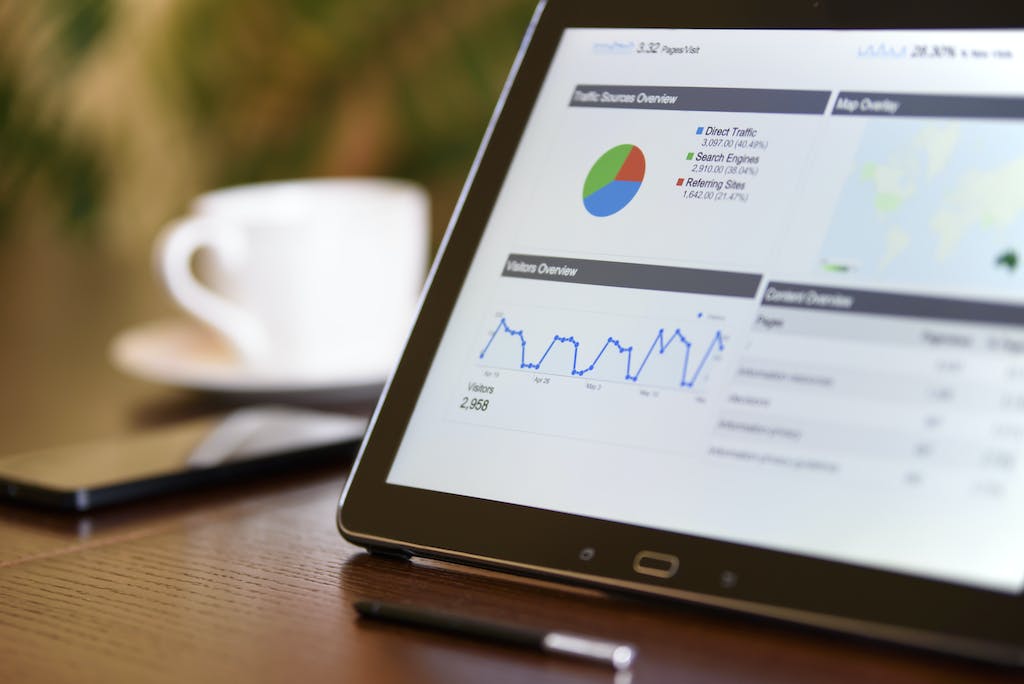How To Use Google Analytics For Your Blog
Are you looking to take your blog to the next level?
Google Analytics is a powerful tool that can provide valuable insights into your blog’s performance and help you optimize your content strategy.
We’ll show you how to use Google Analytics to gain a deeper understanding of your blog’s traffic, audience demographics, and user behavior.
By tracking metrics such as page views, bounce rate, and average session duration, you’ll be able to identify which content resonates with your audience and make data-driven decisions to improve your blog’s performance.
We’ll also explore how to set up conversion and goal tracking, so you can measure the success of your blog in terms of achieving your objectives.
Get ready to unlock the full potential of your blog with Google Analytics!
Setting Up Google Analytics for Your Blog
Setting up Google Analytics for your blog is an absolute must if you want to gain valuable insights and skyrocket your success! It’s a simple process that starts with creating a Google Analytics account.
Once you have your account set up, you’ll need to add a tracking code to your blog. This code is what allows Google Analytics to collect data about your blog’s traffic and user behavior.
To add the tracking code, you’ll need to access your blog’s HTML code. Most blogging platforms have a designated area where you can add custom code. Simply copy the tracking code provided by Google Analytics and paste it into this area. Once the code is added, Google Analytics will start tracking your blog’s performance.
After setting up the tracking code, it’s important to set up goals in Google Analytics. Goals are specific actions you want your blog visitors to take, such as filling out a contact form or making a purchase. By setting up goals, you can track how well your blog is performing in terms of conversions.
In addition to goals, you can also set up custom reports in Google Analytics. These reports allow you to track specific metrics that are important to your blog’s success, such as page views, bounce rate, and average time on page.
Overall, setting up Google Analytics for your blog is a crucial step in understanding your audience and optimizing your content. Don’t miss out on the opportunity to gain valuable insights and drive your blog’s success!
Understanding Your Blog’s Traffic
To get a better grasp of how your blog is performing, it’s important to take a closer look at the traffic it’s attracting. Understanding your blog’s traffic is crucial for making informed decisions to improve its performance and reach a wider audience.
Google Analytics provides valuable insights into your blog’s visitors, allowing you to analyze their behavior and preferences. One of the key metrics you should pay attention to is the number of sessions or visits your blog receives. This metric gives you an overall picture of how many people are visiting your blog within a specific timeframe. By tracking the number of sessions, you can identify trends in your blog’s traffic and determine if your efforts to attract more visitors are paying off.
Google Analytics provides data on the source of your blog’s traffic. This information helps you understand where your visitors are coming from, whether it’s through organic search, social media, or referrals from other websites. By knowing the source of your traffic, you can optimize your marketing strategies and focus on channels that bring in the most visitors.
Furthermore, Google Analytics allows you to analyze the behavior of your blog’s visitors. You can see which pages they visit the most, how long they stay on each page, and whether they bounce off quickly or engage with your content. This data helps you identify popular content and optimize your blog to keep visitors engaged for longer periods.
Understanding your blog’s traffic through Google Analytics is essential for improving its performance and attracting more visitors. By analyzing metrics such as sessions, traffic sources, and visitor behavior, you can make data-driven decisions to optimize your blog and reach a wider audience.
Analyzing Audience Demographics
By examining the demographic data of your blog’s audience, you can gain valuable insights into the characteristics and preferences of your visitors. Google Analytics provides you with a wealth of information about your audience’s age, gender, location, and interests.
Understanding the age range of your audience is crucial for tailoring your content to their preferences. For example, if your blog targets a younger audience, you may want to focus on creating more engaging and visually appealing content. On the other hand, if your audience consists mainly of older individuals, you might want to prioritize informative and educational articles.
Gender data can also help you understand the interests and preferences of your audience. For instance, if you notice that your blog attracts a predominantly female audience, you can create content that resonates with their specific interests.
Analyzing the location of your audience provides valuable insights for targeting specific regions or countries. If you find that a significant portion of your visitors come from a particular location, you can tailor your content to cater to their culture or local interests.
Lastly, understanding the interests of your audience can help you identify popular topics and create content that aligns with their preferences. By analyzing the affinity categories and in-market segments in Google Analytics, you can identify areas of interest that your audience shares.
Analyzing the demographic data of your blog’s audience using Google Analytics can provide you with valuable insights that can help you tailor your content to your visitors’ preferences and ultimately increase engagement on your blog.
Tracking User Behavior on Your Blog
Understanding how visitors interact with your content can be eye-opening and give you valuable insights into what resonates with them. Google Analytics provides you with the tools to track user behavior on your blog, allowing you to see how visitors navigate through your pages, which content they engage with the most, and where they drop off. This information can help you make data-driven decisions to optimize your blog and improve user experience.
One important metric to analyze is the bounce rate, which measures the percentage of visitors who leave your site after viewing only one page. A high bounce rate may indicate that your content isn’t engaging enough or that your navigation is confusing. By identifying the pages with high bounce rates, you can take steps to improve them, such as adding more compelling headlines or enhancing the overall design.
Another useful metric is the average time spent on page. This tells you how long visitors stay on a specific page before navigating away. By analyzing this data, you can determine which pages are holding visitors’ attention the longest and which ones might need improvement. For example, if you notice that visitors are spending a significant amount of time on a particular blog post, you can explore creating similar content to keep them engaged.
Furthermore, tracking user behavior can help you understand the effectiveness of your call-to-action buttons or forms. By monitoring the number of clicks or form submissions, you can identify any issues or areas for improvement. For instance, if you find that visitors aren’t clicking on your call-to-action button as often as you’d like, you can experiment with different placements or designs to increase engagement.
Tracking user behavior on your blog using Google Analytics provides valuable insights into how visitors interact with your content. By analyzing metrics like bounce rate, average time spent on page, and click-through rates, you can make data-driven decisions to optimize your blog and improve user experience.
Identifying Top Performing Content
Discover the blog posts that captivate your audience the most by identifying the top performing content on your site. Google Analytics provides valuable insights into which blog posts are resonating with your readers and driving the most traffic.
By understanding the performance of your content, you can optimize your strategy and create more engaging posts.
To identify the top performing content, start by logging in to your Google Analytics account and navigating to the Behavior section. Click on Site Content and then All Pages. Here, you will see a list of your blog posts ranked by the number of page views they have received. The posts at the top of the list are the ones that have attracted the most attention.
Pay attention not only to the number of page views but also to other metrics such as the average time spent on each page and the bounce rate. These metrics will give you a better understanding of how engaged your readers are with your content. If a blog post has a high number of page views but a high bounce rate as well, it may indicate that the content is not meeting the expectations of your audience.
Identifying the top performing content allows you to learn from your successes and replicate them in future posts. It also helps you understand your audience’s preferences and interests, allowing you to tailor your content to their needs.
By consistently analyzing your top performing content, you can refine your blogging strategy and attract even more readers to your site.
Optimizing Your Content Strategy
Improve your blog’s performance by optimizing your content strategy and delivering more engaging posts to your readers. By analyzing the data provided by Google Analytics, you can gain valuable insights into what content resonates the most with your audience. This allows you to create a more targeted and effective content strategy.
Start by identifying the top-performing posts on your blog. Look at metrics such as page views, bounce rate, and time on page to determine which posts are generating the most traffic and keeping readers engaged. Once you have this information, you can start to analyze the characteristics of these successful posts.
Pay attention to the topics, formats, and writing styles that are driving the most engagement. Look for patterns and trends among your top-performing content. This will help you understand what type of content your audience is looking for and tailor your future posts accordingly.
Consider optimizing your content for search engines. Incorporate relevant keywords into your blog posts to improve your search engine rankings and attract more organic traffic. Use tools like Google Keyword Planner to identify popular keywords in your niche.
Don’t forget to promote your content through various channels. Share your blog posts on social media platforms and engage with your audience. Encourage readers to share your content with others and leave comments. Building a strong online presence and fostering a sense of community can greatly enhance the success of your blog.
By optimizing your content strategy based on the insights provided by Google Analytics, you can deliver more engaging posts to your readers and improve the overall performance of your blog.
Measuring Conversion and Goal Tracking
To effectively gauge the success of your content strategy, track the conversion rates and goals achieved through your blog. Google Analytics provides a comprehensive set of tools to help you measure these conversions and track the progress towards your goals.
Start by setting up your goals in Google Analytics. This could include actions such as newsletter sign-ups, ebook downloads, or purchases. By defining these goals, you can measure the success of your content in driving these conversions.
Once your goals are set, Google Analytics can provide you with valuable insights on how your content is performing. You can track the conversion rate, which is the percentage of visitors who complete a goal, and analyze which pages or blog posts are driving the most conversions. This information can help you identify what content is resonating with your audience and make data-driven decisions to optimize your strategy.
Google Analytics allows you to track the path users take before completing a goal. This can help you understand the customer journey and identify any potential roadblocks or areas for improvement. By analyzing this data, you can optimize your content to guide users towards conversion more effectively.
Measuring conversions and goal tracking is crucial for evaluating the success of your content strategy. Google Analytics provides the necessary tools to track these metrics and make data-driven decisions to optimize your blog.

Now you know how to use Google Analytics for your blog. By setting it up, you can gain valuable insights into your blog’s traffic, audience demographics, and user behavior.
This information will help you identify your top-performing content and optimize your content strategy accordingly. By measuring conversion and goal tracking, you can ensure that your blog is meeting its objectives.
With Google Analytics, you have the tools you need to make data-driven decisions and take your blog to the next level. Keep analyzing, optimizing, and growing!







